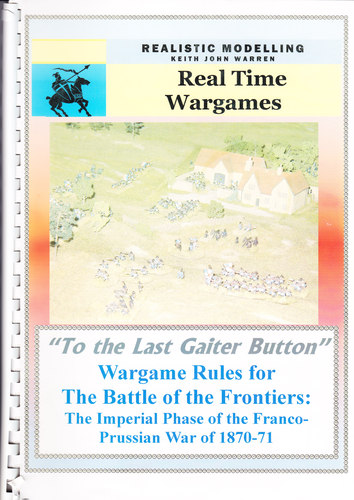|
|
|||||||||||||||||||||||
 |
|
The Rules Directory only works if you help. Write a review. Get the review template here. |
|
TITLE: “To the Last Gaiter Button” Wargame Rules for the Battle of the Frontiers: AUTHORS: Brian Cameron, Bernard Ganley, Nigel Haworth, Peter Merritt, Mukul Patel & Keith Warren PUBLISHER: Realistic Modelling Services PUBLICATION DATE: 2007 WEB SITE/SUPPORT FORUM: www.RealisticModelling.com PRICE: £16.00 in 2011. See website for exchange rates REVIEWED BY: Bernard Ganley (one of the authors) PERIOD COVERED: Franco-Prussian War 1870 THE BOOK: 58 page Ring bound rules with colour cover with b&w content. There is a two-page playsheet (one for the Campaign System, one for the Battlefield), which is also the back cover. Game Aids: Two A3 colour maps of Eastern France, 1 page coloured campaign counters, French Order of Battle Sheet, Confederation Order of Battle Sheet, French Battlefield Display, Confederation Display, French Battlefield Morale Chart, Confederation Battlefield Morale Chart, Campaign Calendar & Battle Clock Sheet, Diplomatic Display Board & Orders of March Sheet. SCOPE: The game combines a campaign system using the game aids noted above and a set of army level battlefield rules to resolve campaign battles. There is also a system for generating one-off battles if you do not want to use the campaign system. ARMY SIZE: The battlefield system is designed to portray corps level battles and above using anything from 6mm to 15mm. The 10mm range from Pendraken are used in the rulebook. Corps are approx 100 - 125 infantry bases, 8 – 20 cavalry bases and 14 - 18 artillery bases per side depending upon nationality. A player can easily handle a corps so these can be used for multi-corps battles. BASE UNIT: The base represents a 250 infantry (A Prussian Coy or a pair of French coys), 125-150 troopers (a squadron) or a battery of 6-8 guns or machine guns. GAME SCALES:
BASING SIZES Use what you have already, but in the rules the following are suggested for 10mm: Line Infantry Base: 30mm x 20mm using 4 figures. 4 bases for a Confederation Battalion, 3 for a French one. All battalions also get a single figure officer figure, while the Elite ones such as Turcos, Foreign Legion, and Prussian Guards have 2. The Reserve Formations of both sides do not get any officer figures. Skirmishers: 30mm circular base with 2 Jaegers/Chasseurs. Confederation Battalions have 6 bases and the French 5 bases. Cavalry: 30mm x 30mm using 3 troopers. 4 bases to a Confederation Regt and 4 or 5 for a French regiment. Heavy regiments also get a single figure officer figure. Artillery: 30 x 30mm with 1 model gun and 3 gunners. Placing a limber or caisson model at the rear of the base denotes a heavy battery. TURN SEQUENCE We will not include the Campaign Turn Sequence, but will include the pre-battle terrain design system and the method for fighting multi-corps battles when you have only a corps worth of figures. Battlefield Display Chart: While fighting your tabletop battle, other formations at the location use a set of linked boxes to resolve their fight with a d6. Depending upon the result the battle might be continued or even forced back. At some point an element of the winning flank force may enter the battle late in the day. By recycling your tabletop losses you can thus carry out a masterstroke by enveloping the enemy or perhaps be saved by a late arriving reserve. Battlefield Terrain: Depending upon how well the defender has chosen his position he can create anything from a “position magnifique” to a position with both his flanks in the air. The defender also has the option to dig hasty scrapes which will reduce his losses, but if lost will lower his formation morale. The turn sequence is as follows:
GAME MECHANICS The rule set includes a campaign system for fighting the war using the two maps and a hidden movement system. There is an onus on the Confederation to advance into France and for the French to assume “positions magnifique”. Depending upon the battlefield results the Diplomatic Chart will influence the political stance of Austria, Denmark, Italy and the South German States. If the French suffer serious reverses the Empire might fall and at first a Council of Regency and then a Government of National Defence might be formed. The campaign will however result in a number of battles with a context. For one-off battles simply fight a corps on corps battle. Clock: Reinforcements only arrive when clock is at 20 (Morning), 40 (Midday) or 60 (Afternoon) and after 60 there is a chance of dusk when ranges are decreased. Once dusk has occurred then there is a chance of nightfall when there is no more movement and only ongoing assaults are resolved. Movement: Is done in 10” squares. Infantry in column move 2 squares, in line 1, cavalry move 2, skirmishers move 2 and artillery move 2 till first deployed after which move 1. Units have to test to leave broken terrain: woods, villages, swamps or crossing bridges. The score needed is if 1d6 score is equal or less than the number of bases left in the unit. Thus to begin with, movement is relatively easy but gets far more difficult once losses are taken. Combat: French artillery can fire 2 squares or 2 km, Confederation artillery 3 square/km. There are rules that allow French regulars with their chassepot rifles to hose an area with long-range fire out to 2 squares. To inflict a hit simply dice against the number of bases in the unit. This is a simple and NICE (Numbers Indicate Combat Effectiveness) system. Artillery have five fire-points, but these are reduced by 1 per square range, with the Prussians getting a +1 modifier for their excellent guns and training. Mitrailleuse batteries are a bit more erratic, but can be deadly at close range. From the raw number of hits inflicted there is a –1 loss if enemy in woods or scrapes, –2 losses if in villages and –3 if in forts. The Close combat system is resolved in the same way of dicing v number of bases left so it is a simple system that does not need lots of tables and charts when there are many units involved. Morale: Only units in a square where an assault has occurred, need to make a morale test and again using the NICE system. If they fail they are bundled out of the contested square; if they pass they may contest or win the square. Loss of Formation Morale: Lose morale points for each 10 bases lost, scrapes overrun, Line of Communication lost. When the Formation Morale is halved then there is a chance that is will have to abandon a variable number of front-line squares. This will keep occurring until a losing formation will sullenly withdraw from the battlefield and admit defeat. ARMY LISTS/SCENARIOS The campaign system will generate battles of various sizes. Or alternatively fight a corps on corps battle using the Battlefield Terrain system mentioned above There are charts and orbats for all the protagonists and how these are represented in the game. REVIEWER’S COMMENTS These rules grew out of
|
|
[Home] [15mm World] [Reviews Home] [How To] [Beginners Guide] [Gamer's World] [Spanner & The Yank] [Points of View] [The Annex] [Links] [Say Howdy] [Corporate Schill] [Rules Directory] |
 |
 The Imperial Phase of the Franco-Prussian War
The Imperial Phase of the Franco-Prussian War